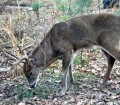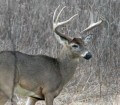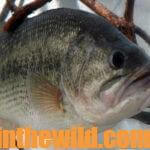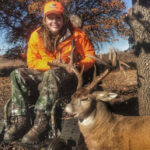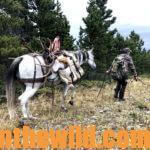John’s Note: How do you hunt the bucks that do all their moving and feeding at night? The problem is tough – but not impossible! Ronnie Groom of Panama City, Florida, has been an avid deer hunter for more than 4 decades and is considered an authority on deer, teaching deer seminars at various hunting lodges.
 Oftentimes deer that are moving in the middle of the day don’t want to go into the thickets and will instead feed along the edges of the thickets. Many times there may be plenty of food just along the edge of thick cover. A big buck may travel along that edge and feed in the middle of the day for two reasons. He knows that the food is there, and he wants to eat some lunch. Secondly, he realizes that if danger does approach – he’s within two steps of cover. He also knows that during the middle of the day the hunters aren’t moving. Therefore the likelihood of a hunter encounter is extremely slim.
Oftentimes deer that are moving in the middle of the day don’t want to go into the thickets and will instead feed along the edges of the thickets. Many times there may be plenty of food just along the edge of thick cover. A big buck may travel along that edge and feed in the middle of the day for two reasons. He knows that the food is there, and he wants to eat some lunch. Secondly, he realizes that if danger does approach – he’s within two steps of cover. He also knows that during the middle of the day the hunters aren’t moving. Therefore the likelihood of a hunter encounter is extremely slim.
So far we’ve learned why deer are nocturnal, and where deer are not nocturnal. We’ve looked at how to hunt deer in the mornings, the evenings and the middle of the day, but we haven’t actually discussed the hunting techniques that the hunters who want to take these phantom deer must employ. As mentioned earlier, being conscious of the wind direction is the most-critical ingredient to taking a nocturnal buck. This is a rule that absolutely can’t be broken – don’t hunt a region where you believe a phantom buck is hiding, if the wind is not in your face.
Another factor that most sportsmen don’t consider when they’re hunting nocturnal bucks is when the hunt actually begins. Keep in mind that hunting nocturnal deer involves attempting to bag one of the smartest deer in all of the woods. Since this buck has learned how to dodge the hunters in the woods, he is much smarter than the buck that dies early in the season. To harvest this kind of buck, you must start to hunt when you leave your vehicle and enter the woods. You can’t slam doors, cough, spit or talk. You must be as quiet as if you think the buck is watching you the entire time. Also make the approach to your hunting site slowly and deliberately. In your preparation to hunt this particular deer, besides already pre-determining your stand site, you should know the route you’re planning to take to that stand. Already have the brush cleared-out along that path ahead of time. Then when you stalk to the stand, your clothes won’t brush up against the foliage and make noise. Wear soft clothing, so that you can move silently, allowing yourself 30 minutes more than what you estimate will be required to reach the stand. Then you will know that you can approach the stand slowly, quietly and deliberately with plenty of time to spare. Too, at your stand site, the leaves and limbs should be cleared away ahead of time. Then when you sit on the ground, you won’t make any noise. If you’re going to use a tree stand, either put the tree stand up early in the season or know that you’ll be able to set-up that tree stand silently.
Already have the brush cleared-out along that path ahead of time. Then when you stalk to the stand, your clothes won’t brush up against the foliage and make noise. Wear soft clothing, so that you can move silently, allowing yourself 30 minutes more than what you estimate will be required to reach the stand. Then you will know that you can approach the stand slowly, quietly and deliberately with plenty of time to spare. Too, at your stand site, the leaves and limbs should be cleared away ahead of time. Then when you sit on the ground, you won’t make any noise. If you’re going to use a tree stand, either put the tree stand up early in the season or know that you’ll be able to set-up that tree stand silently.
Once you climb into your stand before daylight, begin to hunt with your ears, before you hunt with your eyes. Many times if the deer are feeding on acorns, you can hear them popping the nuts before you can see them. If they are traveling through water, you can hear them sloshing. Or, if they are walking through leaves, you can hear them move too. Often you will be able to pinpoint exactly where the deer are before you even have enough light for shooting.
Once you bag your buck and fill your tags for the season, the hunt for next year’s bucks begins. Go back into the woods without a gun during hunting season when the hunting pressure is high to locate areas that the nocturnal bucks go to while they are still utilizing these regions. Many times you will run the bucks out of their sanctuaries, as you move in to look for them. But since you’ve already filled your tags, and you’re not hunting any more in that region this season, whether or not you spook the bucks doesn’t really matter. Most hunters stop hunting when they fill their tags. Therefore they learn very little about what the deer are doing when the hunting pressure is high after their hunts are over. But if you begin your hunts for next season after you’ve completed your hunts for this season, you’ll be much more likely to find and take big bucks next year.
 Hunting is the sport. Bagging a deer is the fulfillment of that sport. I spend many hours after I fill my tag hunting for a place to hunt the following season. Then when I learn that the bucks are becoming nocturnal in certain areas, I know where they must be holed up. Prior to the opening of the season, I can move into these sanctuary areas I have located at the end of last year’s hunting season, set-up stand sites, cut shooting lanes and prepare for a successful hunting season. Then when hunting season arrives, the hunting pressure is high, and the bucks become nocturnal, I’ll be waiting on them.
Hunting is the sport. Bagging a deer is the fulfillment of that sport. I spend many hours after I fill my tag hunting for a place to hunt the following season. Then when I learn that the bucks are becoming nocturnal in certain areas, I know where they must be holed up. Prior to the opening of the season, I can move into these sanctuary areas I have located at the end of last year’s hunting season, set-up stand sites, cut shooting lanes and prepare for a successful hunting season. Then when hunting season arrives, the hunting pressure is high, and the bucks become nocturnal, I’ll be waiting on them.
To get John E. Phillips’ Kindle eBooks and print books on hunting deer, “How to Hunt and Take Big Buck Deer on Small Properties,” “How to Hunt Deer Up Close: With Bows, Rifles, Muzzleloaders and Crossbows,” “PhD Whitetails: How to Hunt and Take the Smartest Deer on Any Property,” “How to Take Monster Bucks,” “How to Hunt Deer Like a Pro,” and “Bowhunting Deer: Mossy Oak Pros Know Bucks and Bows,” or to prepare venison, “Deer & Fixings,” click here.
For information on making jerky from your deer to provide a protein-rich snack, you can download a free book from https://johninthewild.com/free-books.

